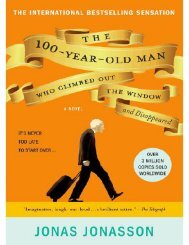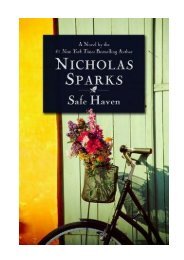Create successful ePaper yourself
Turn your PDF publications into a flip-book with our unique Google optimized e-Paper software.
speakeasy. The shebeens were where men would go to drink after work and during prayer<br />
meetings and most any other time of day as well.<br />
People built homes the way they bought eggs: a little at a time. Every family in the<br />
township was allocated a piece of land by the government. You’d first build a shanty on your<br />
plot, a makeshift structure of plywood and corrugated iron. Over time, you’d save up money<br />
and build a brick wall. One wall. Then you’d save up and build another wall. Then, years later,<br />
a third wall and eventually a fourth. Now you had a room, one room for everyone in your<br />
family to sleep, eat, do everything. Then you’d save up for a roof. Then windows. Then you’d<br />
plaster the thing. Then your daughter would start a family. There was nowhere for them to<br />
go, so they’d move in with you. You’d add another corrugated-iron structure onto your brick<br />
room and slowly, over years, turn that into a proper room for them as well. Now your house<br />
had two rooms. Then three. Maybe four. Slowly, over generations, you’d keep trying to get to<br />
the point where you had a home.<br />
My grandmother lived in Orlando East. She had a two-room house. Not a two-bedroom<br />
house. A two-room house. There was a bedroom, and then there was basically a living<br />
room/kitchen/everything-else room. Some might say we lived like poor people. I prefer “open<br />
plan.” My mom and I would stay there during school holidays. My aunt and cousins would be<br />
there whenever she was on the outs with Dinky. We all slept on the floor in one room, my<br />
mom and me, my aunt and my cousins, my uncle and my grandmother and my greatgrandmother.<br />
The adults each had their own foam mattresses, and there was one big one that<br />
we’d roll out into the middle, and the kids slept on that.<br />
We had two shanties in the backyard that my grandmother would rent out to migrants<br />
and seasonal workers. We had a small peach tree in a tiny patch on one side of the house and<br />
on the other side my grandmother had a driveway. I never understood why my grandmother<br />
had a driveway. She didn’t have a car. She didn’t know how to drive. Yet she had a driveway.<br />
All of our neighbors had driveways, some with fancy, cast-iron gates. None of them had cars,<br />
either. There was no future in which most of these families would ever have cars. There was<br />
maybe one car for every thousand people, yet almost everyone had a driveway. It was almost<br />
like building the driveway was a way of willing the car to happen. The story of Soweto is the<br />
story of the driveways. It’s a hopeful place.<br />
—<br />
Sadly, no matter how fancy you made your house, there was one thing you could never aspire<br />
to improve: your toilet. There was no indoor running water, just one communal outdoor tap<br />
and one outdoor toilet shared by six or seven houses. Our toilet was in a corrugated-iron<br />
outhouse shared among the adjoining houses. Inside, there was a concrete slab with a hole in<br />
it and a plastic toilet seat on top; there had been a lid at some point, but it had broken and<br />
disappeared long ago. We couldn’t afford toilet paper, so on the wall next to the seat was a<br />
wire hanger with old newspaper on it for you to wipe. The newspaper was uncomfortable, but<br />
at least I stayed informed while I handled my business.<br />
The thing that I couldn’t handle about the outhouse was the flies. It was a long drop to<br />
the bottom, and they were always down there, eating on the pile, and I had an irrational, allconsuming<br />
fear that they were going to fly up and into my bum.
















